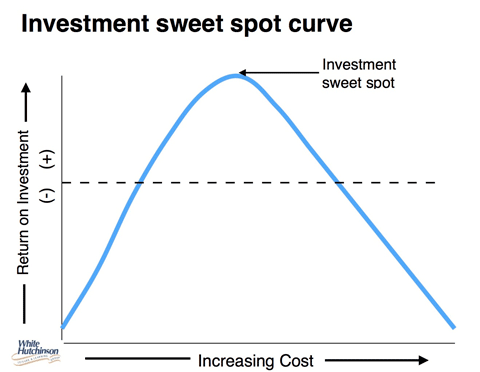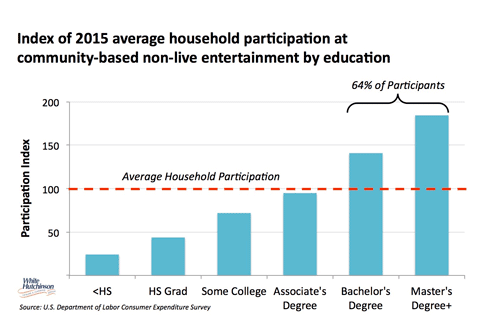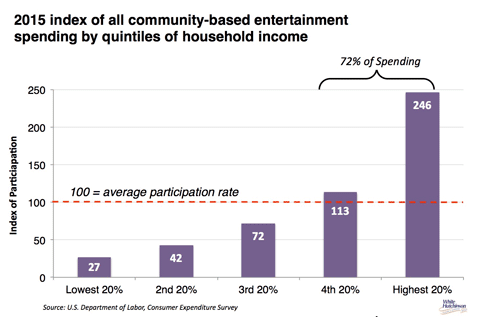
Vol. XVI, No. 9, November 2016
- Editor's Corner
- Meet our CEO at upcoming conventions
- The shrinking children's market; the good news
- What draws restaurant visits?
- A few of our current projects
- Leisure time is a zero-sum game; how much of it will you get?
- Gamerooms are stuck in a time warp
- Preliminary market feasibility analysis
- The Great Pumpkin brings egg-citement to agritainment
- Missing the investment sweet spot can be costly
Missing the investment sweet spot can be costly
One of the great myths about the development of community leisure venues (CLVs), including the many types of location-based entertainment centers, FECs and bowling and laser tag anchored centers, is that the lower the development cost, the greater the return on investment will be. Back in the early days of FECs, in the 1990s, there was some truth to this, as the middle class was a significant target market, FECs had high appeal as a new out-of-home entertainment option, and there was a lot less competition.
A lot has changed since then. Today it's no longer an issue of minimizing the investment to be profitable. Today, it's an issue of hitting the "investment sweet spot" where you don't spend too much or too little, but just the right amount to reach the maximum return-on-investment. And the secret is that the only way to hit that sweet spot is to focus on pleasing your target guests in terms of not just the entertainment, but the quality of all aspects of the overall experience, including the physical environment, the food and beverage and the hospitality.

Today, just as over-investment in a CLV decreases return-on-investment, so does under-investment. In fact, today there is greater risk of failure from under-investing than from over-investing. There is a direct relationship between cost and return before the sweet spot is reached - the greater the cost, the greater the return. Once the sweet spot is reached, the relationship becomes inverse - increasing cost means decreasing return.
The guest experience is the outcome of the guest's interactions with every facet of the facility and its operations. Guests' leisure experiences are shaped by emotional and psychological reactions to the facility and operations, the overall experience, not just the entertainment offerings. Good design is no longer reserved for high-end experiences. Consumers care that they're in a pleasant, well-designed, clean and beautiful environment. Design is all about curating the whole look, tone and feel of the place.
Some of the factors that shape the guest experience include:
- The sensory experience or atmosphere, which includes lighting, sounds, smells, flavors, physical sensations, acoustics, comfort, aesthetic features, and the psychological ambience
- Interpersonal interaction with staff and other guests. Procedures that guests must follow, and their ability to get the information they need to function as guests
- The guests expectations based on all the other location-based business they frequent, including stores, restaurants and other leisure facilities
- The financial and time commitment the guest must make
- It also includes the guests themselves, who are the active participants in "making" their social and fun experiences
The result of the guest experience is a feeling. If it's positive, the CLV is perceived as a good value in terms of cost and time, guests got exactly what they wanted and the CLV is rewarded with repeat business. If the feeling is negative and guests had to make sacrifices, settle for less than they wanted (it only takes one wrong element for this result), the CLV is in trouble.
And today the target market in almost all situations needs to be the upper-middle class, as they account for the lion's share of all CLV participation and spending. In 2015, Bachelor and higher college degree households accounted for more than two-thirds (68%) of all community-based entertainment spending and 64% of community entertainment participation (excluding live performances). Based on incomes, the top 40% of households by income accounted for 72% of all community entertainment spending and 58% of CBE participation (excluding live performances).


The challenge today is to deliver an experience for these higher socioeconomic consumers that not only matches their high expectations that have been created by the many other location-based businesses they visit, but also matches their more sophisticated tastes.
And that's where so many CLVs miss the mark. They design a Denny's quality facility and experience for McCormick & Schmick's customers. This creates a total mismatch between the overall experience, including the physical facility. So the higher socioeconomic consumers just stay away and the CLV only gets a much smaller slice of revenue from the lower socioeconomic.
Along with not matching the investment to the target market's socioeconomics, there are other ways in which developers typically miss the investment sweet spot.
Value engineering
Value engineering is the process of designing unnecessary costs out of a project. Problem is, the process typically occurs after the project is designed and construction bids exceed the budget. Then, it's too late to attack the costs of major building components and systems, where the greatest savings may be possible, without major delays and design costs.
So what gets cut? The finishes and the other things that directly affect the guest experience. So instead of acoustic ceilings, the structure is exposed and noisy. Instead of carpet, it's concrete floors, and instead of comfortable seating, budget furniture. The value of the guest experience is engineered out. The result? A building targeting a Nordstrom customer with a Wal-Mart finish.
Instead of value engineering during the bid phase, it should occur during the design phase when design decisions have the most flexibility and the maximum benefit. And the objective shouldn't just be to lower cost, but to achieve the desired quality of guest experience as economically as possible. To do this, the design team should include not just architects and designers, but the contractor and subcontractors who understand how to cut costs without diminishing the quality of the guest experience. You also need someone who truly understands what the target guests want and what must be maintained to deliver the required experience. That's the approach our company takes on all its design projects. A general contractor and its subcontractors are a part of our design team.
Setting budget independent of needs
Often, investors/developers of CLVs set unrealistic financial expectations for the return. Why determine the investment based upon a 25% return when 20% is the most you can realistically expect? The result is too little investment, on the low side of the investment sweet spot curve, with mediocre, at best, returns.
Unrealistic cost estimates
Unrealistic estimates can result from a number of factors. One of the most common is using square-foot cost estimates, such as estimating the construction will cost $XX per square foot. This is a matter of using averages when they don't match the real life situation. Local building costs and building codes, zoning and regulatory requirements vary greatly from area to area. Big items that are easy to miss include storm water management, impact fees, extension on water mains and fire hydrants for fire protection, building code classification impact on cost, soil conditions, structural changes, etc. Every building renovation project has completely different conditions and requirements. No two are ever the same. When the cost estimate is not thorough and accurate, last-minute revisions remove guest value and add guest sacrifice.
Our company has found that the only way to set budgets that hit the investment sweet spot is to take the CLV's design to a preliminary level during the feasibility stage, designing the project and its specifications to match the target market. This means having a general contractor prepare a realistic construction estimate and it means including the FF&E as well as all soft costs. Every item needs to be identified and accurately accounted for. Does the seating need to include booths, the preferred seating for everyone? Does the seating need to be a 30-minute chair or a two-hour chair? What will shipping and installation cost? And what are the likely soft costs, such as for training, marketing collateral, pre-opening labor and expenses?
With an accurate cost estimate, the developer/investors are in a position to see what their return will be, decide whether to proceed, and have a realistic budget that will hit the investment sweet spot.
Using other CLVs as the benchmark
Often, CLV developers charge forward with their financing based upon what some other projects cost. That project usually is in another area of the country, built years earlier, has many differences and never serves the same market and the same demographic/socioeconomic niche market. Why would a CLV built in a mid-scale market in Tulsa, Oklahoma in 2006 cost the same as a CLV built for an upscale market in Colorado in 2016? The answer is, it won't.
Setting the budget based on a fixed budget
What happens is the feasibility study is conducted, including a schematic plan and a detailed cost estimate. The client looks at it, says they need to reduce the cost. We have also seen this happen when developers say, "That's all I can afford" or "This is the maximum amount I have to invest regardless of what the projections show." So they try to fit 10 gallons of guest experience into an seven-gallon bucket, The projections aren't then revised to reflect that they've reduced the CLV's finishes, critical mass or mix, substantially reducing its draw and per caps. They're surprised, but we aren't, when the CLV at best continually struggles, or often closes several years after it opens, or is sold for much less than its cost, because it cost much less than what was required for to hit the investment sweet spot.
In today's highly competitive leisure market with all its options of where consumers can spend their leisure time and disposable income, the only way for a leisure venue to win is to target a particular market segment and then make sure the venue and its offerings hit the investment sweet spot required to gain the maximum participation and spending by that target market. It's all about finding the sweet spot of success.
Additional reading:
Vol. XVI, No. 9, November 2016
- Editor's Corner
- Meet our CEO at upcoming conventions
- The shrinking children's market; the good news
- What draws restaurant visits?
- A few of our current projects
- Leisure time is a zero-sum game; how much of it will you get?
- Gamerooms are stuck in a time warp
- Preliminary market feasibility analysis
- The Great Pumpkin brings egg-citement to agritainment
- Missing the investment sweet spot can be costly


